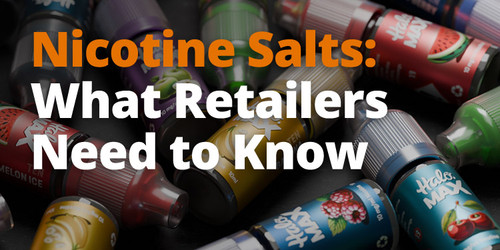Nicotine Salts: What Retailers Need to Know
Published by James Dunworth
Nicotine salts are one of the fastest growing segments of the vape market.
In fact, Imran Ismail of Doozy Vape Co. recently referenced a major increase in sales of nicotine salts, and argued that “the future is nicotine salts and 2023 will see record salt sales.”
It is important for retailers to familiarise themselves with the differences between nicotine salts and other e-liquids, as well as the devices they work with. This can help you provide better customer service. It can also help reduce returns, which can happen when nicotine salts are used with the wrong type of devices.
In this guide we’ll provide a basic introduction to nicotine salts. For a more complete guide to vape products see Stocking Vape Products, A Guide For Retailers.
What are nicotine salts?
Nicotine salts are not a type of sodium, and have no connection to table salt! When we speak about vaping, nicotine salts refer to an e-liquid that contains the same form of nicotine that is found in tobacco leaves.
Nicotine salts are made using a combination of regular (freebase) nicotine and a chemical, often Benzoic acid, which neutralises the nicotine base molecules. The finished product is less acidic than freebase e-liquid.
What are the differences between nicotine salts and freebase e-liquid?
Freebase e-liquids can be harsh on the throat when used with higher nicotine levels. In contrast, nicotine salts are smoother on the throat and are more tolerable for most users.
Nicotine salts are also more stable than freebase e-liquid, and as a result, store better.
Users may also get a faster hit from nicotine salts than from freebase e-liquid. Some scientists believe that nicotine salts hit the bloodstream faster than freebase e-liquids, although there is some debate over this.
Nicotine salts also vapourise at a lower temperature than freebase e-liquids. This makes them ideal for use with low-powered vape devices.
Some vapers also find that they use less nicotine salts than freebase e-liquid. This may be because they absorb more nicotine per ml due to the smoother throat hit. Although nicotine salts are often more expensive than freebase, they may end up being cheaper for vapers in the long term.
What devices can you use nicotine salts with?
In general, nicotine salts are best used with low-wattage devices, such as vape starter kits and basic pod systems. Devices that work well with nicotine salts include the Xros 3 and the Xros 3 Mini.
Higher-powered devices are not usually used with nicotine salts. These are usually designed for thicker e-liquids, and nicotine salts can cause leaking with these devices. Their higher power can also lead to an overwhelming nicotine hit.
What style of vaping are nicotine salts suitable for?
Nicotine salts are ideal for Mouth-to-Lung (MTL) vaping, which is when you inhale vapour into your mouth, hold it for a second and then inhale it into your lungs.
They are not suitable for cloud or sub-ohm vaping, as they do not create as much vapour as freebase e-liquid with a high VG (vegetable glycerine) content.
Why are nicotine salts becoming more popular now?
In recent years disposable device sales have boomed. Now, many users are switching to reusable devices in order to reduce costs and environmental waste.
Disposable devices usually use either nicotine salts or a mixture of nicotine salts and freebase. This means disposables users are already used to nicotine salts, and when they switch to a reusable device they usually prefer the smoother throat hit nicotine salts give. Indeed, one of the most popular nicotine salt types for disposable users is Bar Salts, which replicate the stronger flavours found in disposable vapes. You can learn more about Bar Salts here.
What are some popular nicotine salts brands?
While there are many nicotine salts available, our current best sellers are Halo Vapour Co., Aisu and Elfliq.

